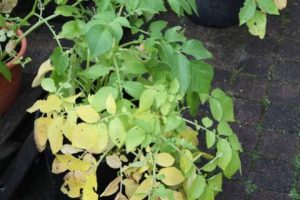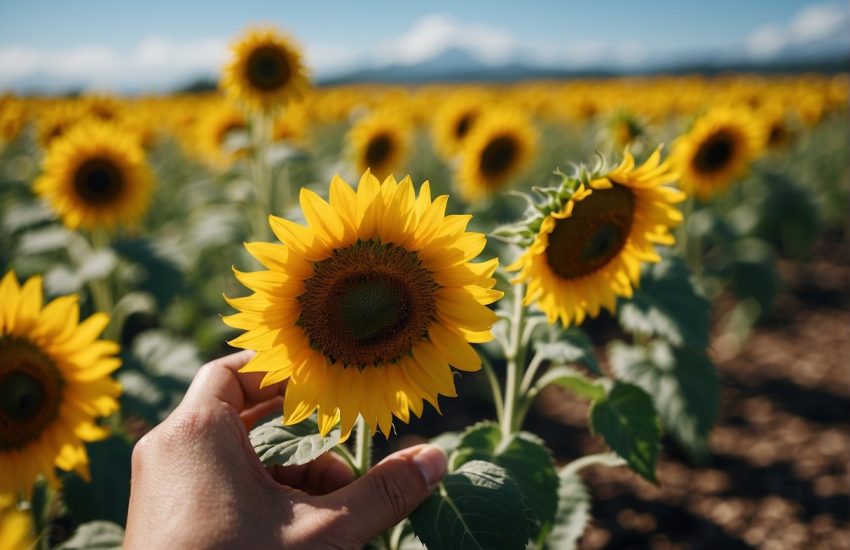How To Prevent Potato Leaves From Turning Yellow
Potato is a common crop for gardeners. It is a cool-weather plant that is vegetatively propagated. They are tubers produced as a highly regulated crop to protect them from diseases. Potatoes are susceptible to various types of pathogens, which cause different types of bacterial and fungal infections.
Growing Potatoes
Potatoes grow best in well-drained and aerated loamy soil rich in organic minerals. Although potatoes prefer slightly acidic soil, they are adaptable and produce quality tubers even when the soil conditions are not perfect. Potatoes grow best when they are planted in a row with adequate spacing. A steady water supply is needed for a good outcome, especially during flowering, but the soil should not be water-logged.

Yellowing of Leaves
Disease prevention is the most important step for potato gardeners. Yellowing of the leaves is one of the setbacks in potatoes. Potatoes leaves are green in color. However, the leaves may yellow before the tubers are ready for harvest. Yellowing of potatoes leaves is common, but if it occurs in high numbers, it could be a sign of a larger issue. Some of the causes and remedies for the yellowing of potatoes leaves are discussed below.
- Wilt
Two types of wilt potatoes cause yellowing in potato leaves: verticillium and fusarium wilt. The two diseases have slight differences, and thus they are not easily distinguished. Yellowing of the lower side of the leaves and drooping are the early symptoms of both types of infections. Later, the entire leaves develop bronzed appearance or black spots.- Verticillium Wilt
Verticillium wilt causes the lower part of potato leaves to turn yellow. The yellow color spread to the upper side of the leave and eventually to the entire plant. The fungal infection also discolors some tubers and vascular tissue of the stem. Low temperature accelerates the infection, but symptoms are most evident during hot weather when the plant is loaded with tubers. Verticillium fungus prevents or limits water uptake; thus, infection is more severe when the temperatures are high, or the plant is water-stressed. - Fusarium Wilt
Fusarium wilt is a fungal infection favored by hot weather. A yellow color appears from the bottom and spreads upwards. The yellow color spread to the stem and plant tissues between the leaf veins. The symptoms may also spread to some tubers. Fusarium fungi survive in the soil for a long period, even without a host.
Preventing yellowing associated with wilt is challenging due to a lack of chemical controls. Growing potatoes in different parts of the land and rotating them with other crops such as legumes, grasses, and cereals can minimize verticillium and Fusarium species. Crop rotation reduces the levels of fungus in the soil that causes wilt. Planting a variety of potatoes resistant to soil diseases can prevent the yellowing of leaves. Besides, planting certified potato seeds is an effective strategy for preventing fungal infection. Certified seeds are thoroughly inspected and thus free from viral diseases. Another remedy for wilt is planting resistant potato varieties such as Kennebec and Irish Cobbler to prevent infection.
- Verticillium Wilt
- Psyllid Yellows
Psyllid yellow is a common potato bacterial infection caused by Bactericerca cockerelli. The infection is characterized by an upright appearance of leaves and yellow foliage. Potato psyllids emit a toxin after feeding, causing a characteristic yellow color in the potato leaves. Initially, the yellow color appears at the edges of the leaves or between veins but eventually spreads to the entire plant. Apart from turning yellow, infested potato leaves curl upward to the stem, a symptom that becomes more evident over time. Potato plants severely affected by potato psyllids develop a pyramid shape and become dwarf.Planting certified seed tubers and whole-drop seed minimize psyllid yellow. A rotation program and strict sanitation practices when cutting seeds prevent the spread of the disease. Severe infection may require the application of insecticides. Imidacloprid is an effective chemical treatment for psyllid yellow. Thorough coverage of foliage is needed to kill all the insects.
- Potato Leaf Miners
Leaf miners are small insects that severely damage potato plants. They tunnel through the leaf surface to feed and lay eggs. The damaged parts of the leaves where leaf miners deposit eggs develop mines. The larvae mine into leaves and eat chloroplast-rich mesophyll causing plant injury and necrosis. Leaf miners interfere with the leaves’ photosynthetic activity, resulting in yellowing. Punctures on the upper surface of the potato leaves allow fungi and bacteria to enter the plant, causing more infection and damage.Insecticides with translaminar properties such as spinosad are effective treatments for controlling leaf miner damage on potatoes leaves. Once the life miner flies digest insecticide, the larvae stop feeding and die within one to two days. Repeated application is needed in potato plants that are severely damaged.
Farmers can also control leaf miners by conserving beneficial insects, parasitoids, or predators. Reducing broad-spectrum insecticides and special weed management practices are some strategies needed to conserve beneficial insects. Parasitoids represent a powerful tool for managing leaf miners by consuming leaf miner larvae.
Leaf miner outbreaks are associated with the repeated application of a broad spectrum of insecticides, which lead to damage to beneficial insects. Integrated pest management controls leaf miners. Multiple management strategies achieve long-term control of leaf miners while reducing the application of insecticides. Crop rotation is also needed as monoculture planting is susceptible to infections.
- Potato Blackleg
Blackleg is a common bacterial infection of potatoes caused by Pectobacterium atrosepticum, a tuber-borne bacteria. The disease depends on growing conditions, particularly rainfall and temperatures. Blackleg attacks potatoes through two routes. First, the bacteria attack potatoes via stolon, an attachment through which tubers are connected to the mother plant. Second, blackleg is transmitted via irrigation water or soil. Several factors influence disease severity, including environmental conditions, the temperature at planting, and soil moisture. A high level of moisture favors infection, and continued high humidity accelerates the spread of the disease.Blackleg occurs at any stage of development. Sometimes blacklegs attack potato plants during the early stages soon after the plants emerge. Early blackleg is characterized by yellowing of leaves and stunted growth. Potatoes plants infected by blackleg are susceptible while conserving beneficial insects. In mature potatoes, the disease appears as black discoloration of the stems accompanied by yellow foliage and rapid wilting. Stem discoloration starts on the lower part and spreads to the upper parts until the entire stem turns black and wilted. The early stages of black leg development are characterized by yellowing of the leaves and wilt, which causes premature senescence before the black decay is evident. Blackleg remains dormant until the conditions become favorable, making the infection unpredictable and severe. Blackleg diseases are transmitted through the tubers.
Prevention of Blackleg
The use of healthy tissue culture in potato seed production is the best approach for preventing blackleg. Planting potatoes in well-drained soil with low nitrogen levels and higher levels of magnesium and calcium is recommended to avoid blackleg development. Tubers grown in soil with low levels of magnesium and calcium are highly susceptible to blackleg infection. There are no resistant potato varieties, but they vary in tolerance. Therefore, selecting the most tolerant variety helps against blackleg infection. Besides, certified seeds reduce the risk of developing a blackleg. Treating seeds with recommended fungicide before planting prevents fungi that lead to blackleg.Removing infected plants reduces soil inoculum, but it is an effective strategy if precautions are taken to prevent contact of healthy plants with the diseased tissues. Most severe infections are from seed-borne blackleg. Physical handling and machinery spread pathogens from one seed to another. Certified seeds are free from blackleg; hence they can prevent infections. Proper sanitation and machinery disinfection decrease the blackleg spread from different seed batches. A rotation program also aids in the control of blackleg.
- Waterlogged Soil
Excess water causes potato leaves to turn yellow. Waterlogging reduces air circulation in the soil. Potato roots are highly sensitive to low oxygen levels, and they are damaged even by short periods of excess water. Overwatering potatoes slows down the growth and increases the likelihood of rot. Poor drainage is associated with a lack of sufficient oxygen for respiration, which causes yellowing in potatoes leaves. Waterlogging restricts potato roots to the soil near the surface, reducing the plant’s nutrients. Insufficient nutrient supply causes yellowing of the leaves. Overwatered potato leaves appear mushy and attract fungal diseases.Sufficient water needs to be supplied to prevent the yellowing of leaves. Several factors should be considered when water is supplied through irrigation. High clay soil requires less water compared to light-textured sandy soils. Besides, the amount of water needed depends on the weather. The water need is higher during hot weather than when the temperatures are low. Maintaining organic matter control water supply in overwatered plants by maintaining an open soil texture which improves drainage.
- Mineral Deficiency
A lack of essential minerals may lead to the yellowing of potato plant leaves. Magnesium, potassium, and nitrogen minerals are vital for healthy potato plant growth.- Magnesium
Magnesium forms a part of chlorophyll and thus is essential for photosynthesis. It plays an important role in ensuring carbohydrates produced in the leaves are translocated to the roots and included in potato yield. Magnesium deficiency reduces potato crop productivity even before visible signs are present. Heavy application of potassium and ammonium fertilizers, acidic soils, sandy soils, and high calcium levels in the soil are some factors leading to magnesium deficiency.Magnesium deficiency reduces potato crop productivity even before visible signs are present. Symptoms of magnesium deficiency begin at the base of the potato plant, where old leaves become yellow with interveinal chlorosis. New leaves can take magnesium from the old leaves due to magnesium mobility.
Remedies for magnesium deficiency in soil include Epsom salt, dolomite lime, sulfate of potash magnesia compost manure, and artificial fertilizers containing magnesium.
- Potassium
Potatoes utilize potassium significantly compared to other nutrients. Potassium is essential in nutrient movement in the potato plant, is necessary for starches and sugars formation, and is involved in over sixty enzyme systems in the plant. Potassium influences tuber size, specific gravity, fry color, sugar content, and storage quality, among others in potatoes.Symptoms of potassium deficiency in potatoes include yellowing of edges and tips of lower leaves and eventually becoming necrotic. As the lack progresses, the yellowing advances between the leaves’ veins and the leave curl up and finally withers and collapses prematurely. Light green interveinal mottle on the mature leaves may precede the yellowing and necrosis.
Yellowing of potato leaves due to potassium deficiency can be prevented by planting in soil enriched with mineral matters such as manure or compost. Other remedies include the use of wood ash, and potassium fertilizers such as muriate of potash, potassium sulfate, and NPK fertilizer.
- Nitrogen
Nitrogen is largely required by potato plants during leaf formation and also for tuber growth. Its availability ensures maximum carbohydrate synthesis in the leaves. At the early stage of crop development, nitrogen helps most of the canopy and maintains the canopy greenness at the later stages, thus maximizing yields.The primary symptom of nitrogen deficiency is a lighter foliage color of the plant leaves. Severe shortage leads to pale yellow and reduced leaf mass. More consequential symptoms like necrosis and wilt and even death of the crops occur when the nitrogen deficiency is not addressed.
Organic and chemical methods can be used to supply crops and the soil with nitrogen. Organic sources include compost manure, animal manure, nitrogen-fixing plants (legumes), groundnut husks, tree leaves, green manure, and edible and non-edible oil cakes. Chemical methods of fixing nitrogen deficiency include nitrogen-containing fertilizers such as urea, nitrolime, and ammonium nitrate.
- Magnesium
The yellowing of potato leaves compromises the quality of the harvest. Rotating crops, proper sanitation, and certified seeds are the best approaches to prevent the yellowing of potato leaves. Sanitation prevents the spread of pathogens from one seed lot to another. Certified seeds are less susceptible to diseases. Crop rotation treats the soil, restores minerals, and kills pathogens that cause the yellowing of potato leaves.


